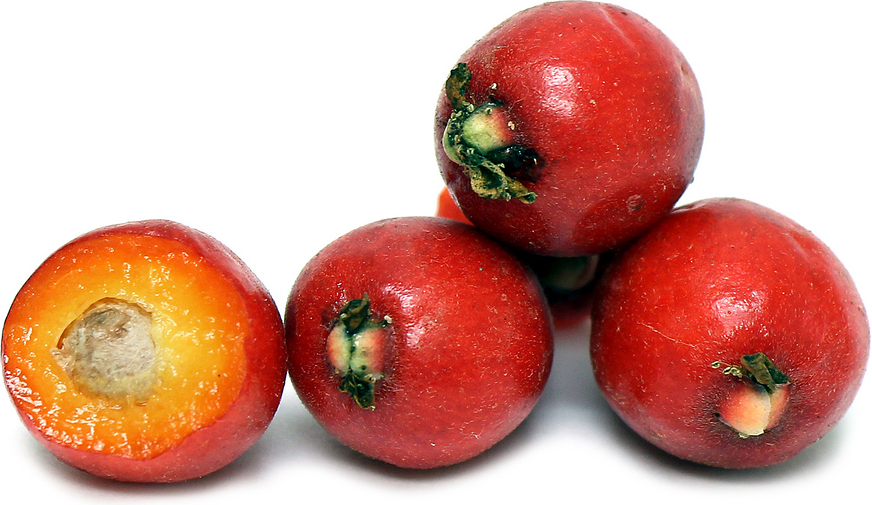


Cedar Bay Cherries
Estimated Inventory, bskt : 0
Description/Taste
Cedar Bay cherries are small, rounded fruits measuring about 2 to 2.5 centimeters in diameter. They have a circular to slightly ovate shape and a rounded bottom. Their skin starts off green and ripens to a vibrant pomegranate-red, attached to a long green stem. This thin, shiny skin is somewhat transparent, with patches of lighter red and faint white dots spread across its surface. When peeled, the bright yellow-orange, succulent flesh, similar to that of a nectarine, is revealed. This soft, juicy flesh is slightly pulpy and stringy, surrounding a beige-colored, hard pit that takes up much of the interior. Cedar Bay cherries have a sweet flavor, with notes of berry and grape.
Seasons/Availability
Cedar Bay cherries are typically available during the summer.
Current Facts
Cedar Bay cherries are botanically known as Eugenia reinwardtiana and belong to the Myrtaceae family, which includes guava, eucalyptus, allspice, cloves, and rose apples. This variety is also called Beach cherries, Fruiting Myrtle, Bushfood, and Bush Tucker. They grow on shrubs or small trees native to the tropical forests of Australia, New Zealand, and the Pacific Islands, reaching 1.5 to 3 meters in height and producing fruit as soon as they grow to about 30 centimeters tall. Cedar Bay cherry trees are valued not only for their sweet, edible fruits but also for their ornamental appeal. These slow-growing shrubs are easily shaped, pruned into hedges or decorative forms, and bloom delicate white flowers.
Nutritional Value
Cedar Bay cherries are a significant source of vitamin C, which plays a crucial role in supporting the immune system, infection defense, and wound healing. This vitamin also aids in collagen production, essential for maintaining skin elasticity, joint health, and reducing signs of aging. The vitamin A in these cherries supports good vision while also maintaining healthy skin and ensuring proper immune function by supporting the development of infection-fighting cells. Their high fiber content promotes healthy digestion, prevents constipation, and supports regular bowel movements. Fiber also slows the absorption of sugar, which is beneficial for maintaining stable energy levels and preventing spikes in blood glucose. Cedar Bay cherries contain antioxidants, including anthocyanins, which combat oxidative stress by neutralizing free radicals. This protection may help reduce the risk of chronic illnesses by limiting inflammation and cellular damage over time.
Applications
Cedar Bay cherries can be used in a variety of dishes, much like conventional cherries. Their small size makes them ideal for fresh snacking, tossing into salads, adding to fruit bowls, or mixing into yogurt parfaits. Pitted cherries can be cooked down into jams, chutneys, and pie fillings. When puréed, they can create a fruity sauce to pair with desserts or meaty entrées like steak and roasted turkey. Halved or pitted fruits can also be incorporated into fruit tarts, muffins, cakes, or used as a topping for ice cream and acai bowls. Cedar Bay cherries can be pressed for juice that can then be used in smoothies, cocktails, slushies, and frozen desserts. To store, keep them refrigerated and consume within one week of harvesting.
Ethnic/Cultural Info
Cedar Bay cherries share their name with a protected area along the Queensland coast of Australia called Cedar Bay National Park. Popular in the 1970s, this park is located in the Daintree rainforest and can only be accessed by boat or on foot. The park features freshwater streams that flow into picturesque white sand beaches. Managed by the Queensland Parks and Wildlife Service, Cedar Bay National Park is home to many Cedar Bay cherry trees, and a permit is required to visit this centuries-old rainforest.
Geography/History
Cedar Bay cherries are native to Eastern Australia. They thrive in tropical climates with abundant sunlight and shaded areas, provided they are planted in well-drained soils. This variety may be foraged from the lush coastal rainforests, rocky beach fronts, and dry creek beds where they naturally grow wild. Cedar Bay cherries are also sown in commercial and private garden settings. These fruits have historically served as a source of sustenance since the time of the Aboriginal Australians, the original inhabitants of this island nation. In addition to Australia, Cedar Bay cherry trees are often grown in Papa New Guinea, Hawaii, Indonesia, and the Pacific Islands. In these places, they may be found at farmers’ markets, specialty stores, and in home gardens.
Recipe Ideas
Recipes that include Cedar Bay Cherries. One
| ABC |
|
Beach Cherry Jam |
Podcast




